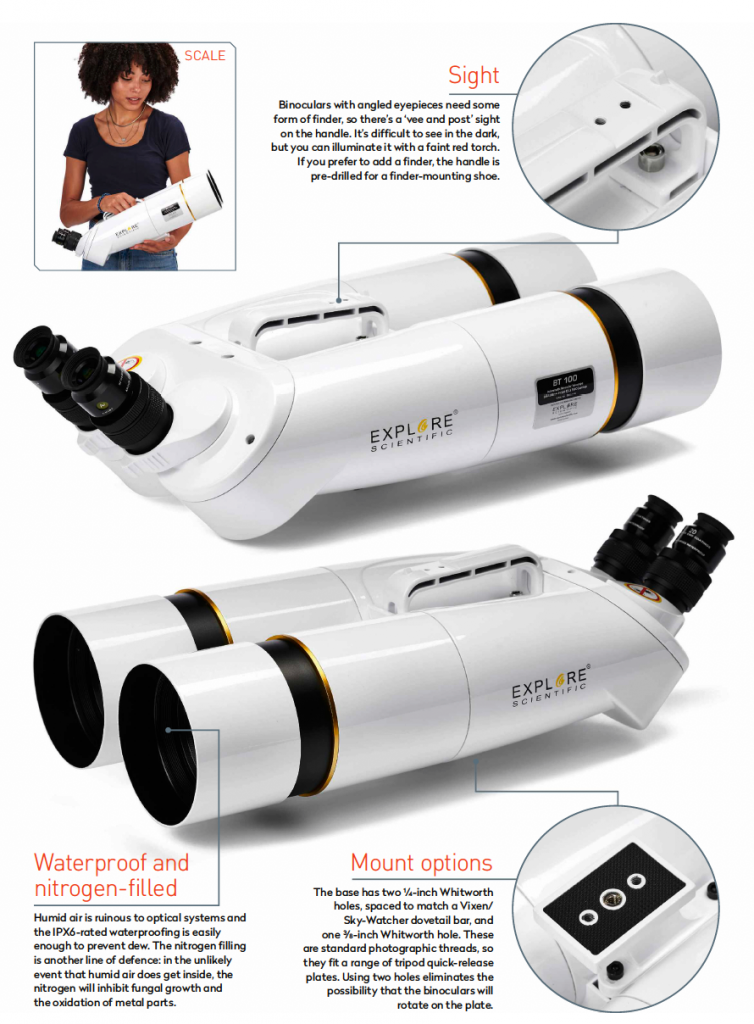A super-sized set of binoculars for views with greater clarity and contrast
VITAL STATS
• Price £1,445.20
• Optics Fully multi-coated (Enhanced Multilayer Deposition)
• Aperture 100mm
• Focal length 550mm, f/5.5
• Eyepieces & magnification 20mm, 28x
• Angular field of view 2.3°
• Focusing Individual focus
• Eye relief 15mm
• Interpupillary distance 54–76mm
• Weight 6.8kg
• Supplier Telescope House
• Tel 01342 837098

Nothing quite matches the pleasure of scanning a clear, dark sky with big binoculars, so Explore Scientific’s new 100 SF Giant Binocular – part of its Binocular Telescope (BT) series – looks like an attractive option, in theory.But how does it fare in practice?
The binoculars come protected in a foam-lined box, which includes the 20mm, 62°, Argon-purged eyepieces. After you’ve secured them into their focusers, you can focus the eyepieces individually with self-centring compression rings. They have fold-down eyecups and just enough eye relief to allow you to see the entire field of view if you wear spectacles. You adjust the interpupillary distance (IPD) – the distance between the pupils of your eyes – with levers on the eyepiece holders. These move smoothly and are sufficiently stiff to make it unlikely that you’ll alter the IPD when you’re focusing or changing eyepieces. The helical focusers rotate smoothly, making it easy to get a pin-sharp view.
For this review the binoculars were mounted on a Universal Astronomics T-Mount (with a load capacity of 13.5kg), which was an ideal platform. There are no trunnions (cylindrical protrusions used as a pivot point) on the BT-100 binoculars for a yoke-type mount. If that’s your preferred option you’ll need a mount with a mounting plate suitable for larger binoculars like those in the BT series, such as Explore Scientific’s U-Mount with tripod. The BT-100’s base can also be attached to camera or video tripods, but you will need a very substantial tripod head to do so.
Two become one
At first light, the binoculars were producing double images. Fortunately, the BT-100 is designed to be collimated by the user. By using a lens spanner to rotate the eccentric rings around the objective lenses and, after a bit of refinement on the star Polaris, we found that the images had merged acceptably. You can’t adjust the eccentrics while you’re at the eyepiece end though, so in-the-field collimation is really a two-person task.
Some false colour is inevitable in a 100mm, f/5.5 achromatic lenses, so we tested them on Vega (Alpha (a) Lyrae). Although it was difficult to detect ‘on-axis’ chromatic aberration – an effect usually seen as coloured rings around brighter objects – at the centre of the field of view, some false colour did become apparent ‘off axis’, further away from the centre of the field of view.
Jupiter and Saturn were shining brightly, low in the southern sky, during the test period and both showed the effects of atmospheric dispersion. It’s possible to counteract this, to some extent, by finding the spot in the bottom half of the field of view where the atmosphere partially corrects chromatic aberration.
At this ‘sweet spot’, Jupiter’s equatorial belts became visible, and it was possible to discern dark space between Saturn’s rings and the planetary disc. A number of faint points of light near Saturn were later revealed as the moons Titan, Tethys, Dione and Rhea after cross-referencing them in a planetarium app.

Reflections and contrasts
When Jupiter was a degree or so below the field of view, it was sometimes possible to see a horizontal flash of light that was probably a reflection of a prism edge. It appeared impossible to induce any spurious reflections from objects that were either within or immediately outside the field of view, however.
The next target was Albireo (Beta (β) Cygni), which displayed two sharp components with the gold and sapphire colour contrast; the rendition was good.
The 1.25-inch eyepieces on the BT-100 are threaded for filters. After inserting a UHC (ultra-high contrast) filter in one, the binoculars revealed the structure in the Dumbbell Nebula. And after panning over to the Ring Nebula, it was possible to ‘blink’ it, making field stars fade and re-emerge by swapping between the filtered and unfiltered eyepieces.
The strength of the BT-100 binoculars is viewing clusters and galaxies. M31 overflows the field of view and M81 and M82 fit easily within it. It was also a joy to identify open clusters in the northern Milky Way.
This is a well-implemented achromatic set of binoculars that will appeal to observers who want a capable, large-aperture instrument without the extra expense of a premium apochromatic design.
Reflection reducers

Look into the objective lenses of the BT-100 binoculars and two things immediately become apparent. The first is how transparent they appear –a consequence of Explore Scientific’s proprietary Enhanced Multilayer Deposition (EMD) antireflective coatings. These use the optical phenomenon of destructive interference to reduce reflection. Light that is not reflected from a transparent surface must be transmitted through that surface, resulting in brighter images.
This transparency allows you to notice the second thing: two rings on the inside of the objective tubes. These are light baffles and their job is to intercept any light reflected off the inside wall of the tubes so that it can’t reach the prisms and eyepieces where it could cause ghost images or image degradation. They are positioned so that they don’t intercept light directly from the objective lenses, so the imageforming light is all transmitted. The result is a bright, high-contrast image in the eyepiece, enabling you to make out subtle detail and detect fainter objects –a desirable trait in any optical device.
KIT TO ADD
1. Explore Scientific U-Mount with tripod for giant binoculars
2. Fotomate VT-680-222R extraheavy-duty professional two-way tripod
3. Explore Scientific 1.25-inch UHC nebula filter